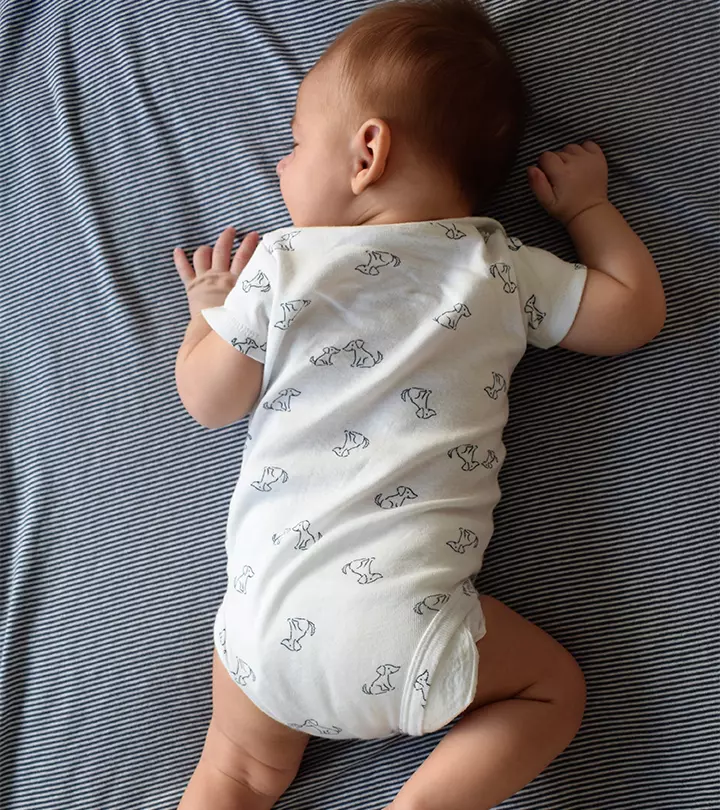
Image: Shutterstock
Hey there new parents! It’s time to buckle up for a thrilling ride as your little one gears up for a special milestone – rolling over! It’s like a front-row seat to your baby’s own acrobatic show! We are here to spill the beans on when rolling over typically happens,some precautions to take and some easy tips on how you can cheer them on. Get ready to witness your tiny explorer flip and flop into new territories! Read on to know more!
When Do Babies Generally Roll Over?
Image: Shutterstock
Generally, most babies start rolling over around the 4 to 6-month mark (1). However, remember that every little munchkin is unique and may hit this milestone a bit earlier or later. Some babies might show off their rolling skills as early as 3 months, while others might take their sweet time until 7 months.
How To Know Your Baby Is Ready To Roll Over?
Watching for signs that your little bundle of joy is gearing up for a roll is like waiting for a sneak peek of the most awaited blockbuster movie. Keep your eyes peeled for these hints:
1. Increased Tummy Time Tolerance
If your baby seems more content during tummy time and can lift their head and chest with ease, rolling over might be on the horizon. Tummy time is like their workout routine, building the muscles needed for rolling.
2. Curious Head Turns
Is your baby trying to catch a glimpse of what’s happening around them? This curiosity is a sign that they are getting ready for more movement. Rolling over allows them to explore their surroundings from a different perspective.
3. Arm Strength
Image: Shutterstock
Notice those mini push-ups during tummy time? As your baby strengthens their arm muscles, they’ll be better equipped for the big roll. It’s like they’re building their very own muscle superhero team.
4. Leg Kicks And Wiggles
If you notice your baby getting excited and giving those little legs a workout, it could be a sign that rolling over is in the cards. Those playful kicks and wiggles are like the warm-up for the grand roll. It is a clear indication that their lower body is gearing up for the action. So, if you catch your baby’s legs doing a dance of their own, get ready for the main event!
How Can You Help Your Baby Roll Over?
Image: Shutterstock
It’s time to become your baby’s biggest cheerleader! Here are some simple ways you can encourage and assist your little one on their rolling adventure:
1. Frequent Tummy Time
This is your baby’s training ground. Gradually increase the duration of tummy time, letting your baby build those essential neck and upper body muscles. Pop down on the bed with them for added encouragement.
2. Interesting Toys
Place colorful and engaging toys just out of reach during tummy time. This will motivate your kid to reach, stretch, and eventually attempt that magical roll. Toys are like the ultimate baby bait!
3. Side-Lying Play
During playtime, encourage your baby to spend some time on their side. This helps them get comfortable with the idea of turning and sets the stage for the big roll. Think of it as a warm up before the grand performance.
4. Gentle Support
Image: Shutterstock
While your baby is on their back, place a soft rolled-up blanket under one side to create a gentle incline. This can make rolling over a bit easier for them, providing a boost without taking away the challenge.
What To Do If There’s A Delay?
No need to worry if your little one hasn’t mastered the art of rolling over by the expected timeframe. Every baby follows their unique timeline, and there can be various reasons for a delay. Here’s what you can do:
1. Consult Your Pediatrician
If you notice a significant delay in your baby’s motor development, it’s always better to check in with a pediatrician. They can offer guidance, assess your baby’s overall development, and offer any necessary interventions if needed.
2. Encourage Movement
Image: Shutterstock
Sometimes, babies just need a little extra encouragement. Spend extra effort on tummy time, engage in playful movements, and provide opportunities for your baby to explore and move at their own pace.
3. Patience Is Key
Remember, every baby is different. Some might take their time perfecting the roll, and that’s perfectly okay. Be patient, and celebrate every small milestone your baby achieves on their unique journey.
The exciting world of baby rolling over is full of twists, turns, and adorable surprises. Keep an eye out for those signs, offer a helping hand, and don’t forget to savor every moment of your little one’s development. Soon enough, you’ll be cheering on your tiny acrobat as they master the art of rolling over, marking yet another milestone in their incredible journey of growth.

















